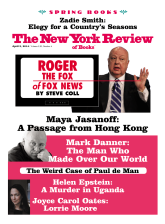In response to:
The Case for Blunders from the March 6, 2014 issue
To the Editors:
The book [Brilliant Blunders, by Mario Livio, reviewed by Freeman Dyson, NYR, March 6] purports to identify blunders made by five scientists. However, the events described are often not blunders, and the reviewer only adds to the muddle. I comment on three scientists.
Darwin’s blunder is claimed to be the blending theory of inheritance. But it was just the theory of inheritance of his time, not his theory. Later Darwin adopted another theory that was popular, pangenesis. This was another error, but not a blunder. Finally Darwin is accused of blundering because he didn’t discover Mendel’s theory of inheritance of discrete traits even though he observed discrete inheritance of flower traits in snapdragons. Here Dyson claims that Darwin’s blunder was lack of an understanding of statistics, and thus [that he] didn’t design experiments to uncover the true 1:3 ratio seen for dominant traits. But the 1:3 ratio is only important in associating traits with chromosomal segregation; it has nothing to do with the basic idea of inheritance of discrete traits. Mendel’s work went unnoticed until 1900, when it was rediscovered and incorporated into the modern theory of genes. To call the failure of Darwin to discover the laws of inheritance in addition to all the work he did a blunder seems unreasonable.
Kelvin is accused of making a blunder in 1887 when he underestimated the age of the earth by a factor of about fifty. In a clever calculation he assumed the heat of the earth was generated by gravitational compression during its formation, and from its present temperature and his estimate for the conduction of heat from the earth he estimated the age. The reviewer claims that Kelvin’s blunder was to ignore the convection of molten rock in the middle of the earth, which would allow a more rapid transfer of heat to space. However, a more rapid transfer of heat would give a smaller value for the age of the earth and thus an even greater error. In fact, Kelvin’s “blunder” was to not know about the heat generated by natural radioactivity of elements in the earth, discovered by Ernest Rutherford in 1903.
Linus Pauling proposed an incorrect structure for DNA in 1953, a few months before the publication by James Watson and Francis Crick of the correct structure. This was a blunder, but it was not assuming the structure was similar to a protein, as stated by Dyson. The blunder was putting the phosphate groups in the middle of the helix, and proposing hydrogen bonds between the phosphates to hold the helix together. In fact the phosphates are all ionized, and the negative charges on the phosphates would cause the molecule to blow apart. As Watson says in The Double Helix, “If a student had made a similar mistake, he would be thought unfit to benefit from Cal Tech’s chemistry faculty.” Pauling was my professor for freshman chemistry at Cal Tech in 1954. I don’t know if I would have recognized his mistake, but I am sure the smarter students in the class would have.
I would advise a student of science not to read this book or the review by Dyson, but to look up the scientists in Wikipedia to get a far more insightful (and correct) history of their careers. References for full-length biographies are cited for those who want more detailed accounts.
Michael Konrad
Sausalito, California
Freeman Dyson sent the following letter to Michael Konrad:
Thank you for your comments on my review of Brilliant Blunders. I learn more from people who disagree with me than from those who agree. I am glad to be corrected when I go wrong, and I have written elsewhere in praise of Wikipedia. The main cause of disagreement in this case is a different understanding of the word “blunder.” To me and to Mario Livio the word carries no blame. We use it in a joking fashion to refer to any proposal or opinion that turns out to be wrong or ignorant. To you the word seems to be judgmental, as if committing a blunder were committing a crime. To me, the main value of Mario Livio’s book is to make blunders respectable.
To the Editors:
I enjoyed Freeman Dyson’s review of Brilliant Blunders [NYR, March 6], particularly his ruminations on why theories—even wrong ones—are a central part of the progress of human understanding. He does, however, make a mistake of his own. He suggests that “the worst political blunder in the history of civilization” was China’s decision to “stop exploring the oceans” in 1433. In fact, the great Zheng He voyages of 1405–1433 were not focused on science or exploration: they were intended primarily to extend China’s influence over the known world and impose its hierarchical model of diplomatic relations. More importantly, the abandonment of the treasure fleets didn’t spell the end of China’s technological, scientific, or economic prominence.
There are some great theories about why China fell behind the West: Mark Elvin’s famous model of agricultural stagnation; the classical idea that China lacked an activist bourgeoisie (an idea held by the great historian of Chinese science, Joseph Needham); Benjamin Elman’s argument that the Chinese lost a conduit to Western knowledge with the dissolution of the Jesuit order in 1773; Kenneth Pomeranz’s argument that China fell behind quite recently, and that the rise of the West was due more to luck than to science or culture or commerce. I’m even working on my own theory. Which of these will turn out to be brilliant blunders and which will survive is hard to tell at this point. But the data make clear that the abandonment of the great voyages was neither a cause nor a tipping point. The divergence was probably much later than historians once believed.
Tonio Andrade
Professor of History
Emory University
Atlanta, Georgia



